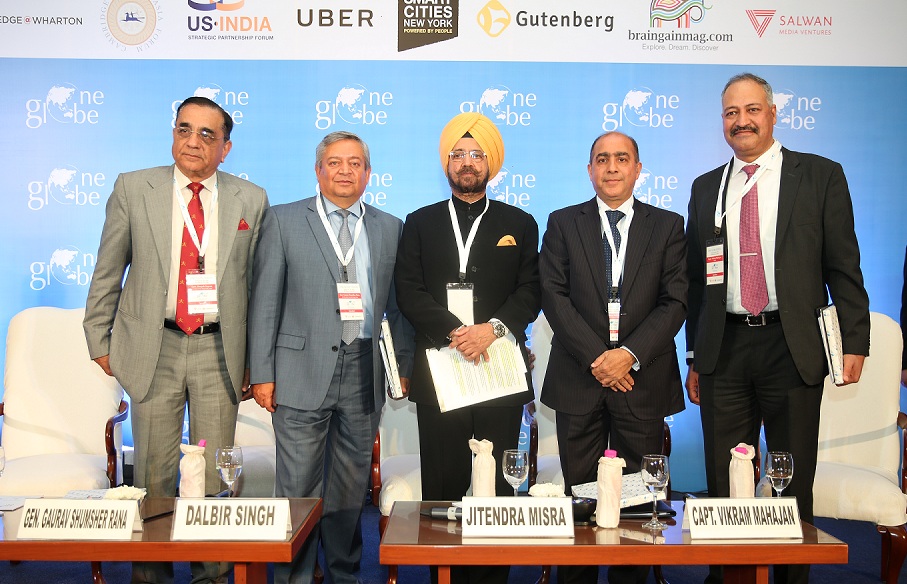South Asia: Evolving Geopolitics and Security Issues
Posted by Admin on May 16, 2018

The rise of India and China, growing population, strategic location, and economic potential have made South Asia an important region internationally. Added to that are the tense political equations within the region, and security threats such as terrorism, drug-trafficking, and radicalized refugees. During the panel discussion on ‘South Asia: Evolving Geopolitics and Security Issues,’ at the One Globe Forum 2018, General Gaurav Shamsher Rana, Former Chief of Army Staff, Nepal, said, “[T]he prevailing global and regional environment, does suggest that any strategic miscalculation by a concerned power could lead to unintended consequences, particularly in the South China Sea, disputed borders in South Asia, and the Indian Ocean.”
The world can no longer ignore South Asia.
General Rana continued, “Unfortunately, this region’s strategic value has been greatly underestimated in the past. The region was considered an outlier in international strategic equations. This outlook, a product of Cold War disposition no longer holds any water.”
General Deepak Kapoor, Former Army Chief, India, explained – “South Asia forms a very important strategic component of the Indo-Pacific region, which is considered as important by the US as any other power. The fact that the US pivot has shifted from Europe to the Indo-Pacific region [should] underline for us the kind of importance the world attaches to the Indo-Pacific region.”
The potential of the region is undermined only by its tensions. Prominent issues impacting South Asia include - the ascending confrontational and competitive rivalry, economic and military, between India and China; the perpetual hostility over borders between India, China and Pakistan; disputed sea-lanes of communication in the Indian Ocean; unabated growth of international and state-sponsored terrorism, poorly regulated borders and other transnational issues; global warming and environment impact; refugee problems of the Rohingya, Bhutanese and Tibetans, which are exacerbated by repressive governments.
The fear and suspicion defining the current cross-border equations have rendered the region vulnerable.
For instance, China’s attempt to refashion the global economic and political order has aroused suspicion within the neighborhood. Firstly, there is the trillion-dollar Chinese ‘Belt and Road Initiative,’ which will span three continents and drive China’s economic, political and cultural advantage.
Then there is Chinese debt-trap diplomacy. China has taken over the strategic Sri Lankan port of Hambantota on a 99-year lease. It has also taken over Pakistan’s strategic Gwadar port. Along with Sri Lanka and Pakistan ports, China also has control of an uninhabited island in Maldives – Feydhoo Finolhu for 50 years. Additionally, 70% of Maldives’ debt is owed to China. This massive lending means increasing political leverage.
As Dr. Jitendra Nath Misra, Former Ambassador to Laos and Portugal, said, the situation “is very fraught from India’s point of view.” There is a serious conflict between the interests of India and China. And the Chinese control of Maldives poses a “very serious security threat.” He added, “Our posture so far has been diplomatic, but I think all options are open, to use the old cliche.”
As for China, General Rana added, “Whether [the rise of China] is going to be benign still remains to be seen as its behavior and actions are transmitting mixed signals. We are moving forward into an undefined turbulent future for sure.”
The situation is being closely watched internationally as well. Capt. Vikram Mahajan, Director – Defence and Aerospace, USISPF, noted that the US, for instance, seems to perceive China’s rise as having undermined the international rules-based order. It is therefore reaching out to New Delhi with the aim of creating political and economic equilibrium. To this end, the US has made a series of diplomatic moves. It has offered to sell the latest in defence technologies, namely the F-16, F/A – 18 fighter planes, to India. It has also proposed sales of the Sea-Guardian UAVs, and the Future Vertical Lift program. Washington also overlooked New Delhi’s vote against its Jerusalem decision in the UN.
Further avenues for cooperation already exist between the US and India. For example, the annual naval exercise – Malabar, which is jointly conducted by the US, India and Japan. Now, the US wants to include Australia and make this a quad. Capt. Mahajan said that this quad is aimed at building cooperation, increasing maritime domain awareness, enabling cyber-security, and facilitating humanitarian assistance and disaster-relief. “However,” as Capt. Mahajan noted, “the unspoken and unwritten fact is that the US wants to keep a check on the dubious plans of China in this region.”
International interest notwithstanding, South Asian nations must look within for solutions to overcome challenges. As Dr. Misra said, “The solution lies in direct dialogue, not in the chancelleries of New York or Geneva.”
For its part, India is a significant, if not the most important, regional player. But, it must become more proactive than reactive in its international approach. The Asia-Africa Growth Corridor designed to link Africa with India and other countries in South East Asia is a move in the right direction, and an appropriate counter to China’s BRI. India must also revive trilateral maritime security measures with Sri Lanka and Maldives. This must further be expanded to include more countries like Seychelles and Mauritius. “We need to take ownership of the Indian Ocean,” Capt. Mahajan noted, “because there is only one ocean in the world named after a nation”
In the long-term interest of the region, all players develop a sophisticated, well-balanced and agile strategy which embraces an adaptable approach to problem-solving and crisis management. As the moderator of the panel, Mr. Dalbir Singh, Chairman, One Globe Forum, remarked, “without political will, without multilateral efforts of all countries involved, it is not possible to arrive at [a comprehensive] solution.”
Watch the Session Vidoe: South Asia: Evolving Geopolitics and Security Issues








